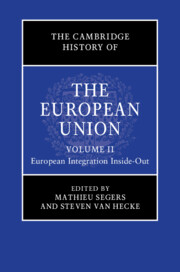Book contents
- The Cambridge History of the European Union
- The Cambridge History of the European Union
- The Cambridge History of the European Union
- Copyright page
- Contents
- Figures
- Tables
- Contributors to Volume II
- Acknowledgements
- Abbreviations
- Reflections on the History and Historiography of European Integration
- Part I Milestones: Treaties and Treaty Changes
- 1 Early Forms of European Unity
- 2 From Messina and Rome to the Single European Act
- 3 The Making of the European Union
- 4 From Maastricht and Copenhagen to Amsterdam and Nice
- 5 The Constitution Project, Lisbon and Beyond
- 6 Moving beyond British Exceptionalism
- Part II Instruments of Integration
- Part III Narratives and Outcomes
- Index
- References
3 - The Making of the European Union
from Part I - Milestones: Treaties and Treaty Changes
Published online by Cambridge University Press: 12 October 2023
- The Cambridge History of the European Union
- The Cambridge History of the European Union
- The Cambridge History of the European Union
- Copyright page
- Contents
- Figures
- Tables
- Contributors to Volume II
- Acknowledgements
- Abbreviations
- Reflections on the History and Historiography of European Integration
- Part I Milestones: Treaties and Treaty Changes
- 1 Early Forms of European Unity
- 2 From Messina and Rome to the Single European Act
- 3 The Making of the European Union
- 4 From Maastricht and Copenhagen to Amsterdam and Nice
- 5 The Constitution Project, Lisbon and Beyond
- 6 Moving beyond British Exceptionalism
- Part II Instruments of Integration
- Part III Narratives and Outcomes
- Index
- References
Summary
Coinciding with radical regional and global changes, the period 1986–93 is a fascinating time in the history of European integration. The fall of the Berlin Wall (November 1989) opened the prospect of ending the division of the European continent and the bipolar world order, raising fundamental questions for both international and intra-European relations.
The momentous events coincided with a renewed dynamism in European integration.1 In June 1985, the member states of the European Communities (EC) had adopted a Commission White Paper with almost 300 measures required to complete the internal market of goods, services, persons and capital by the end of 1992.2 The Single European Act (SEA), a series of treaty amendments aimed at more democratic and effective policy-making, laid the constitutional groundwork for the realisation of this ambitious plan.
- Type
- Chapter
- Information
- The Cambridge History of the European Union , pp. 93 - 117Publisher: Cambridge University PressPrint publication year: 2023

